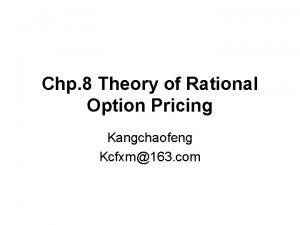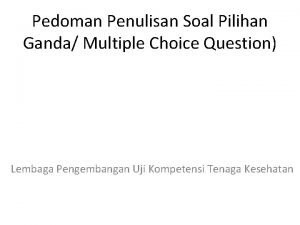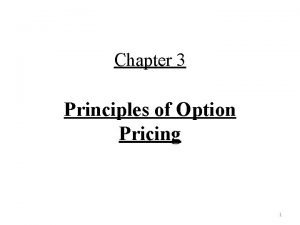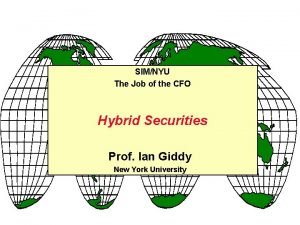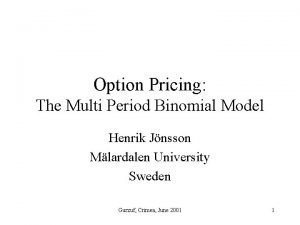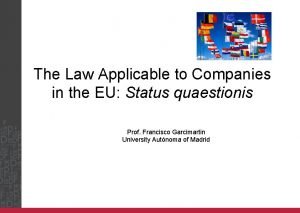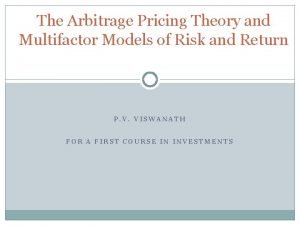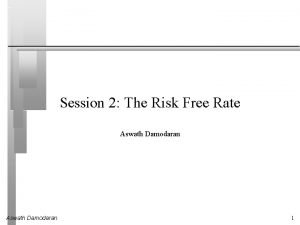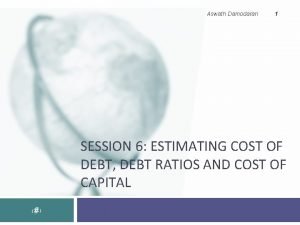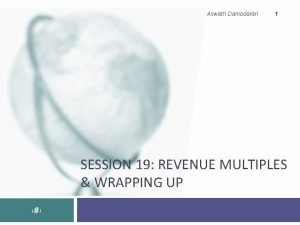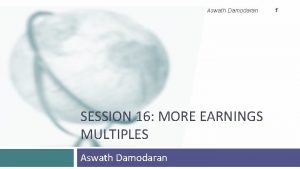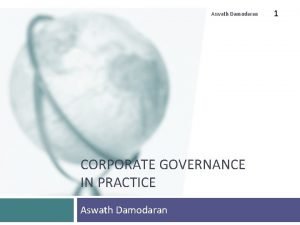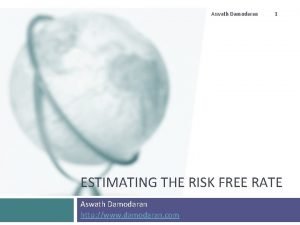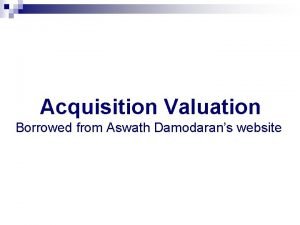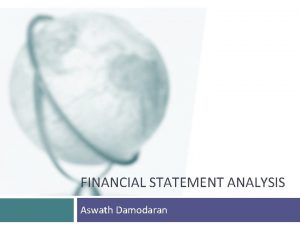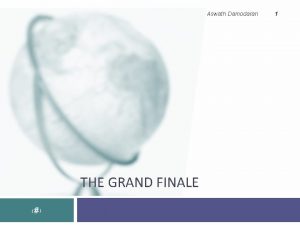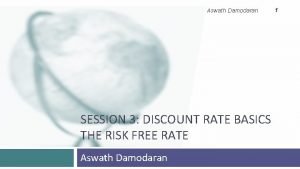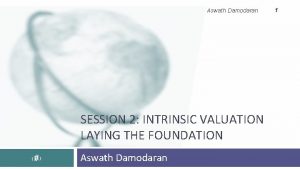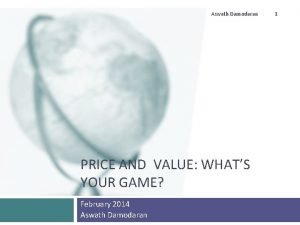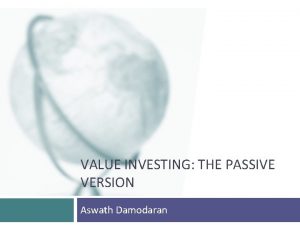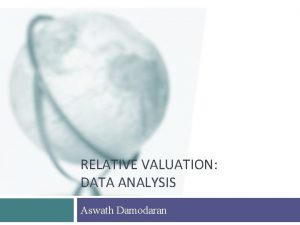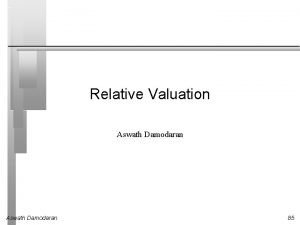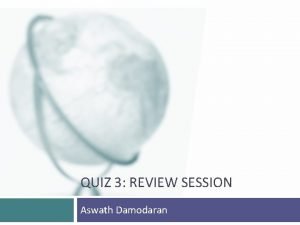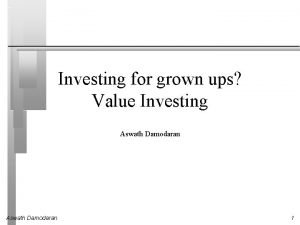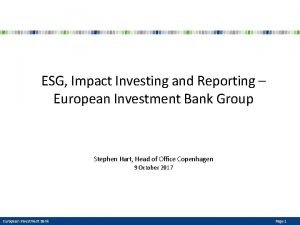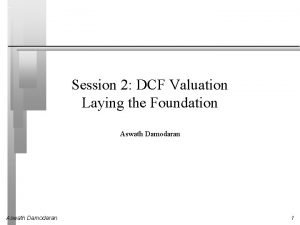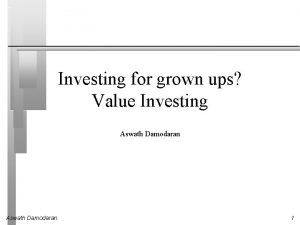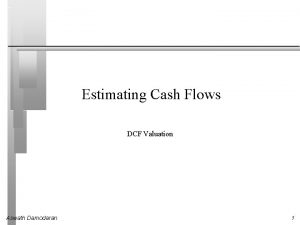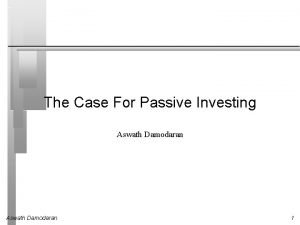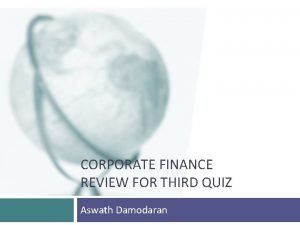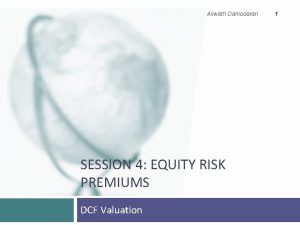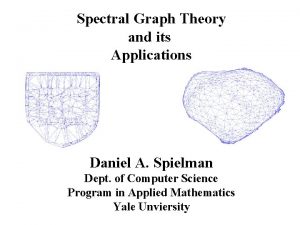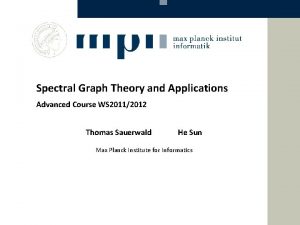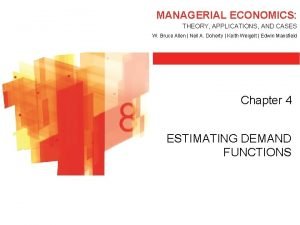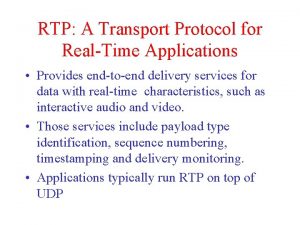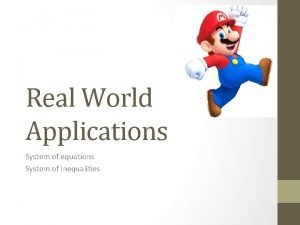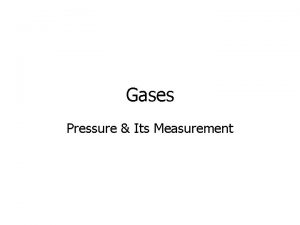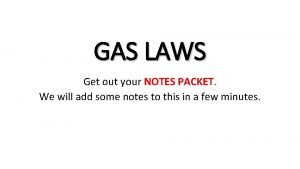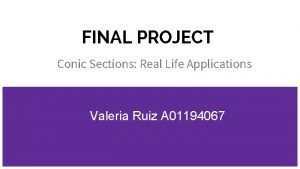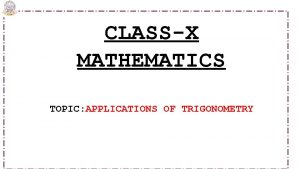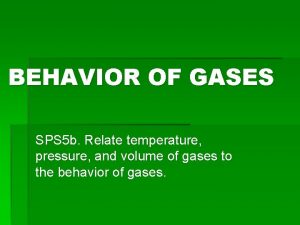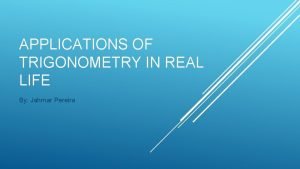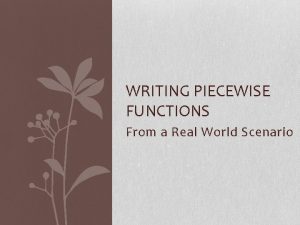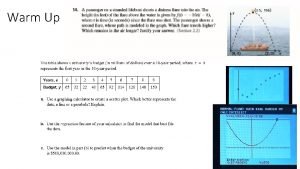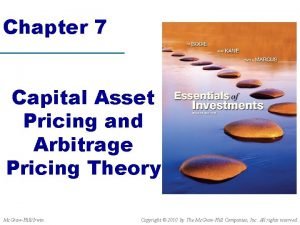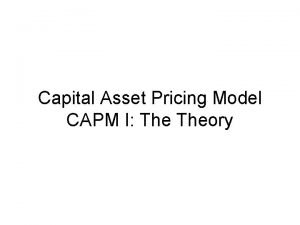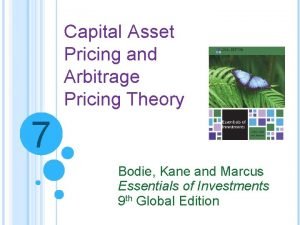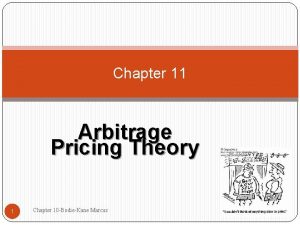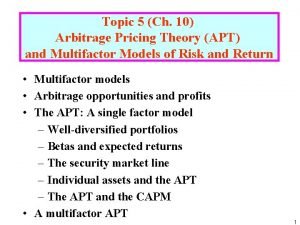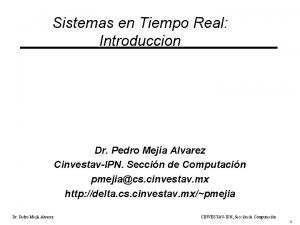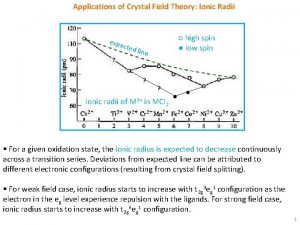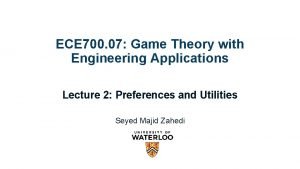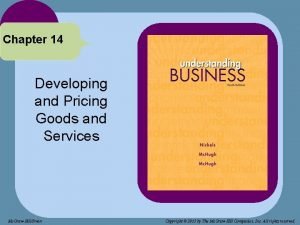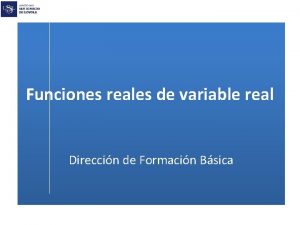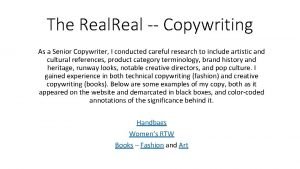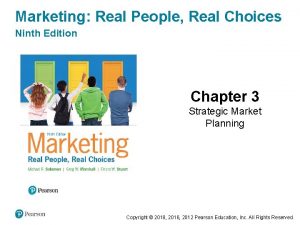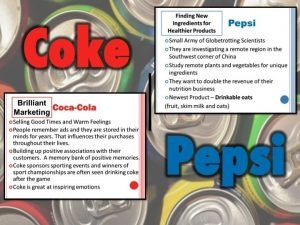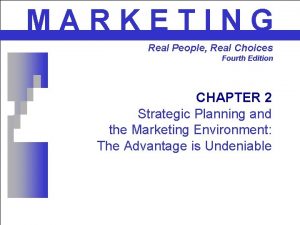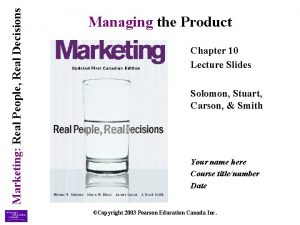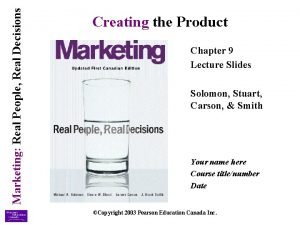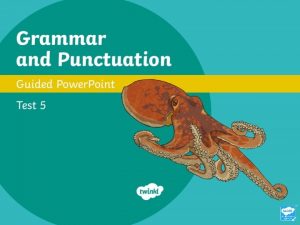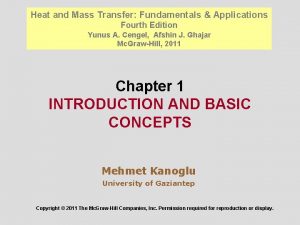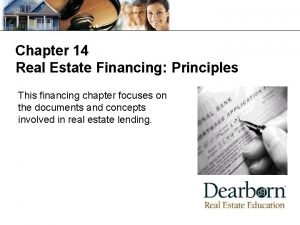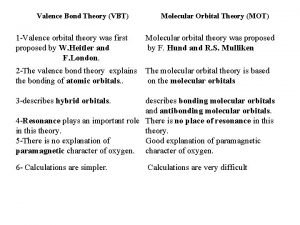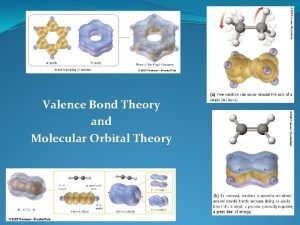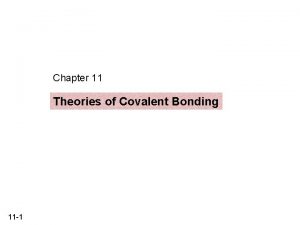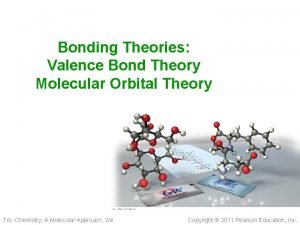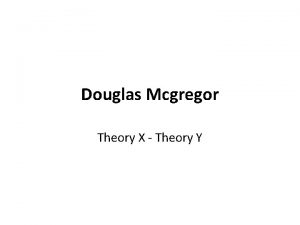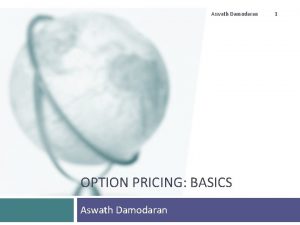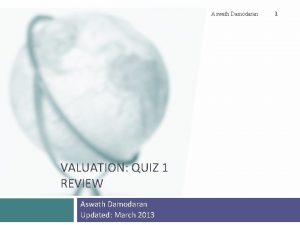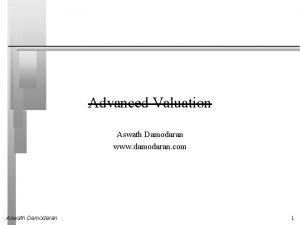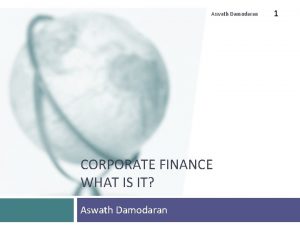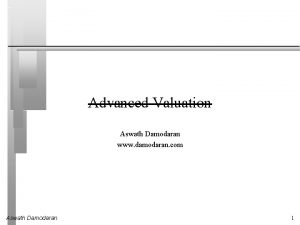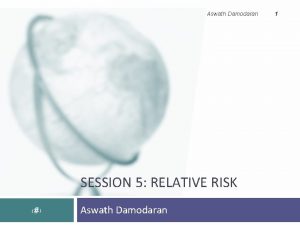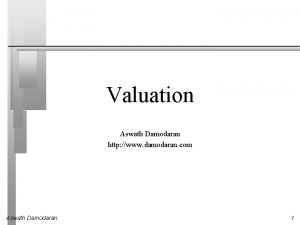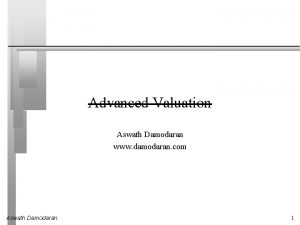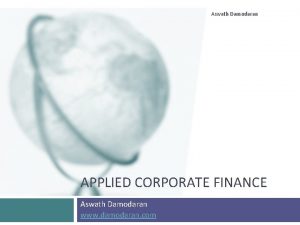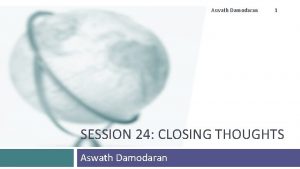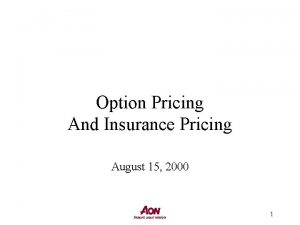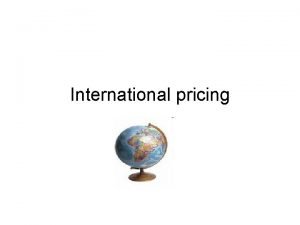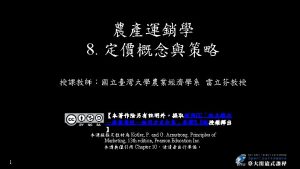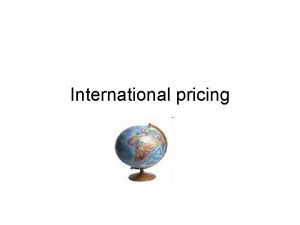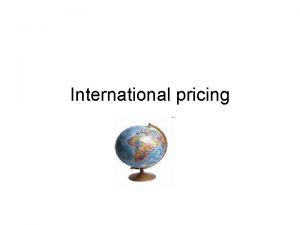Option Pricing Theory and Real Option Applications Aswath


































































































- Slides: 98

Option Pricing Theory and Real Option Applications Aswath Damodaran 1

What is an option? An option provides the holder with the right to buy or sell a specified quantity of an underlying asset at a fixed price (called a strike price or an exercise price) at or before the expiration date of the option. Since it is a right and not an obligation, the holder can choose not to exercise the right and allow the option to expire. There are two types of options - call options (right to buy) and put options (right to sell). Aswath Damodaran 2

Call Options A call option gives the buyer of the option the right to buy the underlying asset at a fixed price (strike price or K) at any time prior to the expiration date of the option. The buyer pays a price for this right. At expiration, • If the value of the underlying asset (S) > Strike Price(K) – Buyer makes the difference: S - K • If the value of the underlying asset (S) < Strike Price (K) – Buyer does not exercise More generally, • the value of a call increases as the value of the underlying asset increases • the value of a call decreases as the value of the underlying asset decreases Aswath Damodaran 3

Payoff Diagram on a Call Net Payoff on Call Strike Price of underlying asset Aswath Damodaran 4

Put Options A put option gives the buyer of the option the right to sell the underlying asset at a fixed price at any time prior to the expiration date of the option. The buyer pays a price for this right. At expiration, • If the value of the underlying asset (S) < Strike Price(K) – Buyer makes the difference: K-S • If the value of the underlying asset (S) > Strike Price (K) – Buyer does not exercise More generally, • the value of a put decreases as the value of the underlying asset increases • the value of a put increases as the value of the underlying asset decreases Aswath Damodaran 5

Payoff Diagram on Put Option Net Payoff On Put Strike Price of underlying asset Aswath Damodaran 6

Determinants of option value Variables Relating to Underlying Asset • Value of Underlying Asset; as this value increases, the right to buy at a fixed price (calls) will become more valuable and the right to sell at a fixed price (puts) will become less valuable. • Variance in that value; as the variance increases, both calls and puts will become more valuable because all options have limited downside and depend upon price volatility for upside. • Expected dividends on the asset, which are likely to reduce the price appreciation component of the asset, reducing the value of calls and increasing the value of puts. Variables Relating to Option • Strike Price of Options; the right to buy (sell) at a fixed price becomes more (less) valuable at a lower price. • Life of the Option; both calls and puts benefit from a longer life. Level of Interest Rates; as rates increase, the right to buy (sell) at a Aswath Damodaran fixed price in the future becomes more (less) valuable. 7

American versus European options: Variables relating to early exercise An American option can be exercised at any time prior to its expiration, while a European option can be exercised only at expiration. • The possibility of early exercise makes American options more valuable than otherwise similar European options. • However, in most cases, the time premium associated with the remaining life of an option makes early exercise sub-optimal. While early exercise is generally not optimal, there are two exceptions: • One is where the underlying asset pays large dividends, thus reducing the value of the asset, and of call options on it. In these cases, call options may be exercised just before an ex-dividend date, if the time premium on the options is less than the expected decline in asset value. • The other is when an investor holds both the underlying asset and deep inthe-money puts on that asset, at a time when interest rates are high. The time premium on the put may be less than the potential gain from exercising the put early and earning interest on the exercise price. Aswath Damodaran 8

A Summary of the Determinants of Option Value Factor Increase in Stock Price Increase in Strike Price Increase in variance of underlying asset Increase in time to expiration Increase in interest rates Increase in dividends paid Aswath Damodaran Call Value Increases Decreases Increases Decreases Put Value Decreases Increases Decreases Increases 9

Creating a replicating portfolio The objective in creating a replicating portfolio is to use a combination of riskfree borrowing/lending and the underlying asset to create the same cashflows as the option being valued. • Call = Borrowing + Buying D of the Underlying Stock • Put = Selling Short D on Underlying Asset + Lending • The number of shares bought or sold is called the option delta. The principles of arbitrage then apply, and the value of the option has to be equal to the value of the replicating portfolio. Aswath Damodaran 10

The Binomial Model Aswath Damodaran 11

The Replicating Portfolio Aswath Damodaran 12

The Limiting Distributions…. As the time interval is shortened, the limiting distribution, as t -> 0, can take one of two forms. • If as t -> 0, price changes become smaller, the limiting distribution is the normal distribution and the price process is a continuous one. • If as t->0, price changes remain large, the limiting distribution is the poisson distribution, i. e. , a distribution that allows for price jumps. The Black-Scholes model applies when the limiting distribution is the normal distribution , and explicitly assumes that the price process is continuous and that there are no jumps in asset prices. Aswath Damodaran 13

The Black-Scholes Model The version of the model presented by Black and Scholes was designed to value European options, which were dividend-protected. The value of a call option in the Black-Scholes model can be written as a function of the following variables: S = Current value of the underlying asset K = Strike price of the option t = Life to expiration of the option r = Riskless interest rate corresponding to the life of the option 2 = Variance in the ln(value) of the underlying asset Aswath Damodaran 14

The Black Scholes Model Value of call = S N (d 1) - K e-rt N(d 2) where, • d 2 = d 1 - √t The replicating portfolio is embedded in the Black-Scholes model. To replicate this call, you would need to • Buy N(d 1) shares of stock; N(d 1) is called the option delta • Borrow K e-rt N(d 2) Aswath Damodaran 15

The Normal Distribution Aswath Damodaran 16

Adjusting for Dividends If the dividend yield (y = dividends/ Current value of the asset) of the underlying asset is expected to remain unchanged during the life of the option, the Black-Scholes model can be modified to take dividends into account. C = S e-yt N(d 1) - K e-rt N(d 2) where, d 2 = d 1 - √t The value of a put can also be derived: P = K e-rt (1 -N(d 2)) - S e-yt (1 -N(d 1)) Aswath Damodaran 17

Problems with Real Option Pricing Models 1. The underlying asset may not be traded, which makes it difficult to estimate value and variance for the underlying asset. 2. The price of the asset may not follow a continuous process, which makes it difficult to apply option pricing models (like the Black Scholes) that use this assumption. 3. The variance may not be known and may change over the life of the option, which can make the option valuation more complex. 4. Exercise may not be instantaneous, which will affect the value of the option. 5. Some real options are complex and their exercise creates other options (compound) or involve learning (learning options) Aswath Damodaran 18

Option Pricing Applications in Investment/Strategic Analysis Aswath Damodaran 19

Options in Projects/Investments/Acquisitions One of the limitations of traditional investment analysis is that it is static and does not do a good job of capturing the options embedded in investment. • The first of these options is the option to delay taking a investment, when a firm has exclusive rights to it, until a later date. • The second of these options is taking one investment may allow us to take advantage of other opportunities (investments) in the future • The last option that is embedded in projects is the option to abandon a investment, if the cash flows do not measure up. These options all add value to projects and may make a “bad” investment (from traditional analysis) into a good one. Aswath Damodaran 20

The Option to Delay When a firm has exclusive rights to a project or product for a specific period, it can delay taking this project or product until a later date. A traditional investment analysis just answers the question of whether the project is a “good” one if taken today. Thus, the fact that a project does not pass muster today (because its NPV is negative, or its IRR is less than its hurdle rate) does not mean that the rights to this project are not valuable. Aswath Damodaran 21

Valuing the Option to Delay a Project PV of Cash Flows from Project Initial Investment in Project Present Value of Expected Cash Flows on Product Project has negative NPV in this section Aswath Damodaran Project's NPV turns positive in this section 22

Insights for Investment Analyses Having the exclusive rights to a product or project is valuable, even if the product or project is not viable today. The value of these rights increases with the volatility of the underlying business. The cost of acquiring these rights (by buying them or spending money on development, for instance) has to be weighed off against these benefits. Aswath Damodaran 23

Example 1: Valuing product patents as options A product patent provides the firm with the right to develop the product and market it. It will do so only if the present value of the expected cash flows from the product sales exceed the cost of development. If this does not occur, the firm can shelve the patent and not incur any further costs. If I is the present value of the costs of developing the product, and V is the present value of the expected cashflows from development, the payoffs from owning a product patent can be written as: Payoff from owning a product patent =V-I if V> I =0 if V ≤ I Aswath Damodaran 24

Payoff on Product Option Net Payoff to introduction Cost of product introduction Present Value of cashflows on product Aswath Damodaran 25

Obtaining Inputs for Patent Valuation Aswath Damodaran 26

Valuing a Product Patent: Avonex Biogen, a bio-technology firm, has a patent on Avonex, a drug to treat multiple sclerosis, for the next 17 years, and it plans to produce and sell the drug by itself. The key inputs on the drug are as follows: PV of Cash Flows from Introducing the Drug Now = S = $ 3. 422 billion PV of Cost of Developing Drug for Commercial Use = K = $ 2. 875 billion Patent Life = t = 17 years Riskless Rate = r = 6. 7% (17 -year T. Bond rate) Variance in Expected Present Values = 2 = 0. 224 (Industry average firm variance for bio-tech firms) Expected Cost of Delay = 1/17 = 5. 89% d 1 = 1. 1362 N(d 1) = 0. 8720 d 2 = -0. 8512 N(d 2) = 0. 2076 Call Value= 3, 422 exp(-0. 0589)(17) (0. 8720) - 2, 875 (exp(-0. 067)(17) (0. 2076)= $ 907 million Aswath Damodaran 27

Patent Life and Exercise… Aswath Damodaran 28

Valuing a firm with patents The value of a firm with a substantial number of patents can be derived using the option pricing model. Value of Firm = Value of commercial products (using DCF value + Value of existing patents (using option pricing) + (Value of New patents that will be obtained in the future – Cost of obtaining these patents) The last input measures the efficiency of the firm in converting its R&D into commercial products. If we assume that a firm earns its cost of capital from research, this term will become zero. If we use this approach, we should be careful not to double count and allow for a high growth rate in cash flows (in the DCF valuation). Aswath Damodaran 29

Value of Biogen’s existing products Biogen had two commercial products (a drug to treat Hepatitis B and Intron) at the time of this valuation that it had licensed to other pharmaceutical firms. · The license fees on these products were expected to generate $ 50 million in after-tax cash flows each year for the next 12 years. To value these cash flows, which were guaranteed contractually, the pretax cost of debt of 7% of the licensing firms was used: Present Value of License Fees = $ 50 million (1 – (1. 07)-12)/. 07 = $ 397. 13 million · Aswath Damodaran 30

Value of Biogen’s Future R&D · · · Biogen continued to fund research into new products, spending about $ 100 million on R&D in the most recent year. These R&D expenses were expected to grow 20% a year for the next 10 years, and 5% thereafter. It was assumed that every dollar invested in research would create $ 1. 25 in value in patents (valued using the option pricing model described above) for the next 10 years, and break even after that (i. e. , generate $ 1 in patent value for every $ 1 invested in R&D). There was a significant amount of risk associated with this component and the cost of capital was estimated to be 15%. Aswath Damodaran 31

Value of Future R&D Yr Value of Patents 1 $ 150. 00 2 $ 180. 00 3 $ 216. 00 4 $ 259. 20 5 $ 311. 04 6 $ 373. 25 7 $ 447. 90 8 $ 537. 48 9 $ 644. 97 10 $ 773. 97 R&D Cost Excess Value $ $ $ $ $ 120. 00 144. 00 172. 80 207. 36 248. 83 298. 60 358. 32 429. 98 515. 98 619. 17 30. 00 36. 00 43. 20 51. 84 62. 21 74. 65 89. 58 107. 50 128. 99 154. 79 Present Value (at 15%) $ 26. 09 $ 27. 22 $ 28. 40 $ 29. 64 $ 30. 93 $ 32. 27 $ 33. 68 $ 35. 14 $ 36. 67 $ 38. 26 $ Aswath Damodaran 318. 30 32

Value of Biogen The value of Biogen as a firm is the sum of all three components – the present value of cash flows from existing products, the value of Avonex (as an option) and the value created by new research: Value = Existing products + Existing Patents + Value: Future R&D = $ 397. 13 million + $ 907 million + $ 318. 30 million = $1622. 43 million Since Biogen had no debt outstanding, this value was divided by the number of shares outstanding (35. 50 million) to arrive at a value per share: Value per share = $ 1, 622. 43 million / 35. 5 = $ 45. 70 Aswath Damodaran 33

Example 2: Valuing Natural Resource Options In a natural resource investment, the underlying asset is the resource and the value of the asset is based upon two variables - the quantity of the resource that is available in the investment and the price of the resource. In most such investments, there is a cost associated with developing the resource, and the difference between the value of the asset extracted and the cost of the development is the profit to the owner of the resource. Defining the cost of development as X, and the estimated value of the resource as V, the potential payoffs on a natural resource option can be written as follows: • • Aswath Damodaran Payoff on natural resource investment = V - X if V > X =0 if V≤ X 34

Payoff Diagram on Natural Resource Firms Net Payoff on Extraction Cost of Developing Reserve Value of estimated reserve of natural resource Aswath Damodaran 35

Estimating Inputs for Natural Resource Options Aswath Damodaran 36

Valuing an Oil Reserve Consider an offshore oil property with an estimated oil reserve of 50 million barrels of oil, where the present value of the development cost is $12 per barrel and the development lag is two years. The firm has the rights to exploit this reserve for the next twenty years and the marginal value per barrel of oil is $12 per barrel currently (Price per barrel - marginal cost per barrel). Once developed, the net production revenue each year will be 5% of the value of the reserves. The riskless rate is 8% and the variance in ln(oil prices) is 0. 03. Aswath Damodaran 37

Inputs to Option Pricing Model Current Value of the asset = S = Value of the developed reserve discounted back the length of the development lag at the dividend yield = $12 * 50 /(1. 05)2 = $ 544. 22 (If development is started today, the oil will not be available for sale until two years from now. The estimated opportunity cost of this delay is the lost production revenue over the delay period. Hence, the discounting of the reserve back at the dividend yield) Exercise Price = Present Value of development cost = $12 * 50 = $600 million Time to expiration on the option = 20 years Variance in the value of the underlying asset = 0. 03 Riskless rate =8% Dividend Yield = Net production revenue / Value of reserve = 5% Aswath Damodaran 38

Valuing the Option Based upon these inputs, the Black-Scholes model provides the following value for the call: d 1 = 1. 0359 d 2 = 0. 2613 N(d 1) = 0. 8498 N(d 2) = 0. 6030 Call Value= 544. 22 exp(-0. 05)(20) (0. 8498) -600 (exp(-0. 08)(20) (0. 6030)= $ 97. 08 million This oil reserve, though not viable at current prices, still is a valuable property because of its potential to create value if oil prices go up. Aswath Damodaran 39

Extending the option pricing approach to value natural resource firms Since the assets owned by a natural resource firm can be viewed primarily as options, the firm itself can be valued using option pricing models. The preferred approach would be to consider each option separately, value it and cumulate the values of the options to get the firm value. Since this information is likely to be difficult to obtain for large natural resource firms, such as oil companies, which own hundreds of such assets, a variant is to value the entire firm as one option. A purist would probably disagree, arguing that valuing an option on a portfolio of assets (as in this approach) will provide a lower value than valuing a portfolio of options (which is what the natural resource firm really own). Nevertheless, the value obtained from the model still provides an interesting perspective on the determinants of the value of natural resource firms. Aswath Damodaran 40

Inputs to the Model Input to model Corresponding input for valuing firm Value of underlying asset Value of cumulated estimated reserves of the resource owned by the firm, discounted back at the dividend yield for the development lag. Exercise Price Estimated cumulated cost of developing estimated reserves Time to expiration on option Average relinquishment period across all reserves owned by firm (if known) or estimate of when reserves will be exhausted, given current production rates. Riskless rate corresponding to life of the option Variance in value of asset Variance in the price of the natural resource Dividend yield Estimated annual net production revenue as percentage of value of the reserve. Aswath Damodaran 41

Valuing Gulf Oil Gulf Oil was the target of a takeover in early 1984 at $70 per share (It had 165. 30 million shares outstanding, and total debt of $9. 9 billion). It had estimated reserves of 3038 million barrels of oil and the average cost of developing these reserves was estimated to be $10 a barrel in present value dollars (The development lag is approximately two years). The average relinquishment life of the reserves is 12 years. The price of oil was $22. 38 per barrel, and the production cost, taxes and royalties were estimated at $7 per barrel. The bond rate at the time of the analysis was 9. 00%. Gulf was expected to have net production revenues each year of approximately 5% of the value of the developed reserves. The variance in oil prices is 0. 03. Aswath Damodaran 42

Valuing Undeveloped Reserves • Value of underlying asset = Value of estimated reserves discounted back for period of development lag= 3038 * ($ 22. 38 - $7) / 1. 052 = $42, 380. 44 • Exercise price = Estimated development cost of reserves = 3038 * $10 = $30, 380 million • Time to expiration = Average length of relinquishment option = 12 years • Variance in value of asset = Variance in oil prices = 0. 03 • Riskless interest rate = 9% • Dividend yield = Net production revenue/ Value of developed reserves = 5% Based upon these inputs, the Black-Scholes model provides the following value for the call: d 1 = 1. 6548 d 2 = 1. 0548 N(d 1) = 0. 9510 N(d 2) = 0. 8542 Call Value= 42, 380. 44 exp(-0. 05)(12) (0. 9510) -30, 380 (exp(-0. 09)(12) (0. 8542)= $ 13, 306 million Aswath Damodaran 43

Valuing Gulf Oil In addition, Gulf Oil had free cashflows to the firm from its oil and gas production of $915 million from already developed reserves and these cashflows are likely to continue for ten years (the remaining lifetime of developed reserves). The present value of these developed reserves, discounted at the weighted average cost of capital of 12. 5%, yields: • Value of already developed reserves = 915 (1 - 1. 125 -10)/. 125 = $5065. 83 Adding the value of the developed and undeveloped reserves Value of production in place Total value of firm Less Outstanding Debt Value of Equity Value per share Aswath Damodaran = $ 13, 306 million = $ 5, 066 million = $ 18, 372 million = $ 9, 900 million = $ 8, 472/165. 3 = $51. 25 44

The Option to Expand/Take Other Projects Taking a project today may allow a firm to consider and take other valuable projects in the future. Thus, even though a project may have a negative NPV, it may be a project worth taking if the option it provides the firm (to take other projects in the future) provides a more-than-compensating value. These are the options that firms often call “strategic options” and use as a rationale for taking on “negative NPV” or even “negative return” projects. Aswath Damodaran 45

The Option to Expand PV of Cash Flows from Expansion Additional Investment to Expand Present Value of Expected Cash Flows on Expansion Firm will not expand in this section Aswath Damodaran Expansion becomes attractive in this section 46

An Example of an Expansion Option Ambev is considering introducing a soft drink to the U. S. market. The drink will initially be introduced only in the metropolitan areas of the U. S. and the cost of this “limited introduction” is $ 500 million. A financial analysis of the cash flows from this investment suggests that the present value of the cash flows from this investment to Ambev will be only $ 400 million. Thus, by itself, the new investment has a negative NPV of $ 100 million. If the initial introduction works out well, Ambev could go ahead with a full-scale introduction to the entire market with an additional investment of $ 1 billion any time over the next 5 years. While the current expectation is that the cash flows from having this investment is only $ 750 million, there is considerable uncertainty about both the potential for the drink, leading to significant variance in this estimate. Aswath Damodaran 47

Valuing the Expansion Option Value of the Underlying Asset (S) = PV of Cash Flows from Expansion to entire U. S. market, if done now =$ 750 Million Strike Price (K) = Cost of Expansion into entire U. S market = $ 1000 Million We estimate the standard deviation in the estimate of the project value by using the annualized standard deviation in firm value of publicly traded firms in the beverage markets, which is approximately 34. 25%. • Standard Deviation in Underlying Asset’s Value = 34. 25% Time to expiration = Period for which expansion option applies = 5 years Call Value= $ 234 Million Aswath Damodaran 48

Considering the Project with Expansion Option NPV of Limited Introduction = $ 400 Million - $ 500 Million = - $ 100 Million Value of Option to Expand to full market= $ 234 Million NPV of Project with option to expand = - $ 100 million + $ 234 million = $ 134 million Invest in the project Aswath Damodaran 49

The Link to Strategy In many investments, especially acquisitions, strategic options or considerations are used to take investments that otherwise do not meet financial standards. These strategic options or considerations are usually related to the expansion option described here. The key differences are as follows: • Unlike “strategic options” which are usually qualitative and not valued, expansion options can be assigned a quantitative value and can be brought into the investment analysis. • Not all “strategic considerations” have option value. For an expansion option to have value, the first investment (acquisition) must be necessary for the later expansion (investment). If it is not, there is no option value that can be added on to the first investment. Aswath Damodaran 50

The Exclusivity Requirement in Option Value Aswath Damodaran 51

The Determinants of Real Option Value Does taking on the first investment/expenditure provide the firm with an exclusive advantage on taking on the second investment? • If yes, the firm is entitled to consider 100% of the value of the real option • If no, the firm is entitled to only a portion of the value of the real option, with the proportion determined by the degree of exclusivity provided by the first investment? Is there a possibility of earning significant and sustainable excess returns on the second investment? • If yes, the real option will have significant value • If no, the real option has no value Aswath Damodaran 52

Internet Firms as Options Some analysts have justified the valuation of internet firms on the basis that you are buying the option to expand into a very large market. What do you think of this argument? • Is there an option to expand embedded in these firms? • Is it a valuable option? Aswath Damodaran 53

The Option to Abandon A firm may sometimes have the option to abandon a project, if the cash flows do not measure up to expectations. If abandoning the project allows the firm to save itself from further losses, this option can make a project more valuable. PV of Cash Flows from Project Cost of Abandonment Present Value of Expected Cash Flows on Project Aswath Damodaran 54

Valuing the Option to Abandon Airbus is considering a joint venture with Lear Aircraft to produce a small commercial airplane (capable of carrying 40 -50 passengers on short haul flights) • Airbus will have to invest $ 500 million for a 50% share of the venture • Its share of the present value of expected cash flows is 480 million. Lear Aircraft, which is eager to enter into the deal, offers to buy Airbus’s 50% share of the investment anytime over the next five years for $ 400 million, if Airbus decides to get out of the venture. A simulation of the cash flows on this time share investment yields a variance in the present value of the cash flows from being in the partnership is 0. 16. The project has a life of 30 years. Aswath Damodaran 55

Project with Option to Abandon Value of the Underlying Asset (S) = PV of Cash Flows from Project = $ 480 million Strike Price (K) = Salvage Value from Abandonment = $ 400 million Variance in Underlying Asset’s Value = 0. 16 Time to expiration = Life of the Project =5 years Dividend Yield = 1/Life of the Project = 1/30 = 0. 033 (We are assuming that the project’s present value will drop by roughly 1/n each year into the project) Assume that the five-year riskless rate is 6%. The value of the put option can be estimated as follows: Aswath Damodaran 56

Should Airbus enter into the joint venture? Value of Put =Ke-rt (1 -N(d 2))- Se-yt (1 -N(d 1)) =400 (exp(-0. 06)(5) (1 -0. 4624) - 480 exp(-0. 033)(5) (1 -0. 7882) = $ 73. 23 million The value of this abandonment option has to be added on to the net present value of the project of -$ 20 million, yielding a total net present value with the abandonment option of $ 53. 23 million. Aswath Damodaran 57

Implications for Investment Analysis Having a option to abandon a project can make otherwise unacceptable projects acceptable. Actions that increase the value of the abandonment option include • More cost flexibility, that is, making more of the costs of the projects into variable costs as opposed to fixed costs. • Fewer long-term contracts/obligations with employees and customers, since these add to the cost of abandoning a project • Finding partners in the investment, who are willing to acquire your investment in the future These actions will undoubtedly cost the firm some value, but this has to be weighed off against the increase in the value of the abandonment option. Aswath Damodaran 58

Option Pricing Applications in the Capital Structure Decision Aswath Damodaran 59

Options in Capital Structure The most direct applications of option pricing in capital structure decisions is in the design of securities. In fact, most complex financial instruments can be broken down into some combination of a simple bond/common stock and a variety of options. • If these securities are to be issued to the public, and traded, the options have to be priced. • If these are non-traded instruments (bank loans, for instance), they still have to be priced into the interest rate on the instrument. The other application of option pricing is in valuing flexibility. Often, firms preserve debt capacity or hold back on issuing debt because they want to maintain flexibility. Aswath Damodaran 60

The Value of Flexibility Firms maintain excess debt capacity or larger cash balances than are warranted by current needs, to meet unexpected future requirements. While maintaining this financing flexibility has value to firms, it also has a cost; the excess debt capacity implies that the firm is giving up some value and has a higher cost of capital. The value of flexibility can be analyzed using the option pricing framework; a firm maintains large cash balances and excess debt capacity in order to have the option to take projects that might arise in the future. Aswath Damodaran 61

Determinants of Value of Flexibility Option Quality of the Firm’s Projects: It is the excess return that the firm earns on its projects that provides the value to flexibility. Other things remaining equal, firms operating in businesses where projects earn substantially higher returns than their hurdle rates should value flexibility more than those that operate in stable businesses where excess returns are small. Uncertainty about Future Projects: If flexibility is viewed as an option, its value will increase when there is greater uncertainty about future projects; thus, firms with predictable capital expenditures and excess returns should value flexibility less than those with high variability in both of those variables. Aswath Damodaran 62

Value of Flexibility as an Option Consider a firm that has expected reinvestment needs of X each year, with a standard deviation in that value of X. These external reinvestments include both internal projects and acquisitions. Assume that the firm can raise L from internal cash flows and its normal access to capital markets. (Normal access refers to the external financing that is used by a firm each year) Excess debt capacity becomes useful if external reinvestment needs exceed the firm’s internal funds. If X > L: Excess debt capacity can be used to cover the difference and invest in projects If X<L: Excess debt capacity remains unused (with an associated cost) Aswath Damodaran 63

What happens when you make the investment? If the investment earns excess returns, the firm’s value will increase by the present value of these excess returns over time. If we assume that the excess return each year is constant and perpetual, the present value of the excess returns that would be earned can be written as: Value of investment = (ROC - Cost of capital)/ Cost of capital The value of the investments that you can take because you have excess debt capacity becomes the payoff to maintaining excess debt capacity. If X > L: [(ROC - Cost of capital)/ Cost of capital] New investments If X<L: 0 Aswath Damodaran 64

The Value of Flexibility Aswath Damodaran 65

Disney’s Optimal Debt Ratio Cost of Equity Cost of Debt 0. 00% 13. 00% 4. 61% 13. 00% 10. 00% 13. 43% 4. 61% 12. 55% Current: 18%13. 85% 4. 80% 12. 22% 20. 00% 13. 96% 4. 99% 12. 17% 30. 00% 14. 65% 5. 28% 11. 84% 40. 00% 15. 56% 5. 76% 11. 64% 50. 00% 16. 85% 6. 56% 11. 70% 60. 00% 18. 77% 7. 68% 12. 11% 70. 00% 21. 97% 7. 68% 11. 97% 80. 00% 28. 95% 7. 97% 12. 17% 90. 00% 52. 14% 9. 42% 13. 69% Aswath Damodaran Cost of Capital 66

Inputs to Option Valuation Model To value flexibility as a percent of firm value (as an annual cost), these would be the inputs to the model: • S = Expected Reinvestment needs as percent of Firm Value • K = Expected Reinvestment needs that can be financed without financing flexibility • t = 1 year 2 = Variance in ln(Net Capital Expenditures) Once this option has been valued, estimate the present value of the excess returns that will be gained by taking the additional investments by multiplying by (ROC - WACC)/WACC Aswath Damodaran 67

The Inputs for Disney Expected reinvestment needs as a percent of firm value: • Over the last 5 years, reinvestment (net cap ex, acquisitions and changes in working capital) has been approximately 5. 3% of firm value • I am assuming that this is the expected reinvestment need; the variance in ln(reinvestment) over the last 5 years is 0. 375 Reinvestment needs that can be financed without flexibility. • We looked at internal funds, after debt payments but before reinvestment needs, as a percent of firm value over the last 5 years. (Internal funds = (Net Income + Depreciation)/Market Value of the Firm) • We looked at net debt financing each period, as a percent of firm value (as a measure of access to external financing each year). (New Debt - Debt Repaid)/Market Value of Firm) • Reinvestment needs that can be financed without flexibility = (Net Income + Depreciation + Net Debt Issued)/Market Value of Firm • This number has averaged 4. 8%, over the last 5 years Aswath Damodaran 68

Valuing Flexibility at Disney The value of flexibility as a percentage of firm value can be estimated as follows: S = 5. 3% K = 4. 8% t = 1 year 2 = 0. 375 ( Variance in ln(Reinvestment Needs/Firm Value)) The value of an option with these characteristics is 1. 6092% Disney earns 18. 69% on its projects has a cost of capital of 12. 22%. The excess return (annually) is 6. 47%. Value of Flexibility (annual)= 1. 6092%(. 0647/. 1222) = 0. 85 % of value Disney’s cost of capital at its optimal debt ratio is 11. 64%. The cost it incurs to maintain flexibility is therefore 0. 58% annually (12. 22%11. 64%). It therefore pays to maintain flexibility. Aswath Damodaran 69

Determinants of the Value of Flexibility Capacity to raise funds to meet financing needs: The greater the capacity to raise funds, either internally or externally, the less the value of flexibility. • 1. 1: Firms with significant internal operating cash flows should value flexibility less than firms with small or negative operating cash flows. • 1. 2: Firms with easy access to financial markets should have a lower value for flexibility than firms without that access. Unpredictability of reinvestment needs: The more unpredictable the reinvestment needs of a firm, the greater the value of flexibility. Capacity to earn excess returns: The greater the capacity to earn excess returns, the greater the value of flexibility. • 1. 3: Firms that do not have the capacity to earn or sustain excess returns get no value from flexibility. Aswath Damodaran 70

Option Pricing Applications in Valuation Equity Value in Deeply Troubled Firms Value of Undeveloped Reserves for Natural Resource Firm Value of Patent/License Aswath Damodaran 71

Option Pricing Applications in Equity Valuation Equity in a troubled firm (i. e. a firm with high leverage, negative earnings and a significant chance of bankruptcy) can be viewed as a call option, which is the option to liquidate the firm. Natural resource companies, where the undeveloped reserves can be viewed as options on the natural resource. Start-up firms or high growth firms which derive the bulk of their value from the rights to a product or a service (eg. a patent) Aswath Damodaran 72

Valuing Equity as an option The equity in a firm is a residual claim, i. e. , equity holders lay claim to all cashflows left over after other financial claim-holders (debt, preferred stock etc. ) have been satisfied. If a firm is liquidated, the same principle applies, with equity investors receiving whatever is left over in the firm after all outstanding debts and other financial claims are paid off. The principle of limited liability, however, protects equity investors in publicly traded firms if the value of the firm is less than the value of the outstanding debt, and they cannot lose more than their investment in the firm. Aswath Damodaran 73

Equity as a call option The payoff to equity investors, on liquidation, can therefore be written as: Payoff to equity on liquidation = V - D if V > D =0 if V ≤ D where, V = Value of the firm D = Face Value of the outstanding debt and other external claims A call option, with a strike price of K, on an asset with a current value of S, has the following payoffs: Payoff on exercise Aswath Damodaran =S-K =0 if S > K if S ≤ K 74

Payoff Diagram for Liquidation Option Aswath Damodaran 75

Application to valuation: A simple example Assume that you have a firm whose assets are currently valued at $100 million and that the standard deviation in this asset value is 40%. Further, assume that the face value of debt is $80 million (It is zero coupon debt with 10 years left to maturity). If the ten-year treasury bond rate is 10%, • how much is the equity worth? • What should the interest rate on debt be? Aswath Damodaran 76

Model Parameters Value of the underlying asset = S = Value of the firm = $ 100 million Exercise price = K = Face Value of outstanding debt = $ 80 million Life of the option = t = Life of zero-coupon debt = 10 years Variance in the value of the underlying asset = 2 = Variance in firm value = 0. 16 Riskless rate = r = Treasury bond rate corresponding to option life = 10% Aswath Damodaran 77

Valuing Equity as a Call Option Based upon these inputs, the Black-Scholes model provides the following value for the call: • d 1 = 1. 5994 • d 2 = 0. 3345 N(d 1) = 0. 9451 N(d 2) = 0. 6310 Value of the call = 100 (0. 9451) - 80 exp(-0. 10)(10) (0. 6310) = $75. 94 million Value of the outstanding debt = $100 - $75. 94 = $24. 06 million Interest rate on debt = ($ 80 / $24. 06)1/10 -1 = 12. 77% Aswath Damodaran 78

The Effect of Catastrophic Drops in Value o o o Assume now that a catastrophe wipes out half the value of this firm (the value drops to $ 50 million), while the face value of the debt remains at $ 80 million. What will happen to the equity value of this firm? It will drop in value to $ 25. 94 million [ $ 50 million - market value of debt from previous page] It will be worth nothing since debt outstanding > Firm Value It will be worth more than $ 25. 94 million Aswath Damodaran 79

Illustration : Value of a troubled firm Assume now that, in the previous example, the value of the firm were reduced to $ 50 million while keeping the face value of the debt at $80 million. This firm could be viewed as troubled, since it owes (at least in face value terms) more than it owns. The equity in the firm will still have value, however. Aswath Damodaran 80

Valuing Equity in the Troubled Firm Value of the underlying asset = S = Value of the firm = $ 50 million Exercise price = K = Face Value of outstanding debt = $ 80 million Life of the option = t = Life of zero-coupon debt = 10 years Variance in the value of the underlying asset = 2 = Variance in firm value = 0. 16 Riskless rate = r = Treasury bond rate corresponding to option life = 10% Aswath Damodaran 81

The Value of Equity as an Option Based upon these inputs, the Black-Scholes model provides the following value for the call: • d 1 = 1. 0515 • d 2 = -0. 2135 N(d 1) = 0. 8534 N(d 2) = 0. 4155 Value of the call = 50 (0. 8534) - 80 exp(-0. 10)(10) (0. 4155) = $30. 44 million Value of the bond= $50 - $30. 44 = $19. 56 million The equity in this firm drops by, because of the option characteristics of equity. This might explain why stock in firms, which are in Chapter 11 and essentially bankrupt, still has value. Aswath Damodaran 82

Equity value persists. . Aswath Damodaran 83

Valuing equity in a troubled firm The first implication is that equity will have value, even if the value of the firm falls well below the face value of the outstanding debt. Such a firm will be viewed as troubled by investors, accountants and analysts, but that does not mean that its equity is worthless. Just as deep out-of-the-money traded options command value because of the possibility that the value of the underlying asset may increase above the strike price in the remaining lifetime of the option, equity will command value because of the time premium on the option (the time until the bonds mature and come due) and the possibility that the value of the assets may increase above the face value of the bonds before they come due. Aswath Damodaran 84

The Conflict between bondholders and stockholders Stockholders and bondholders have different objective functions, and this can lead to conflicts between the two. For instance, stockholders have an incentive to take riskier projects than bondholders do, and to pay more out in dividends than bondholders would like them to. This conflict between bondholders and stockholders can be illustrated dramatically using the option pricing model. • Since equity is a call option on the value of the firm, an increase in the variance in the firm value, other things remaining equal, will lead to an increase in the value of equity. • It is therefore conceivable that stockholders can take risky projects with negative net present values, which while making them better off, may make the bondholders and the firm less valuable. This is illustrated in the following example. Aswath Damodaran 85

Illustration: Effect on value of the conflict between stockholders and bondholders Consider again the firm described in the earlier example , with a value of assets of $100 million, a face value of zero-coupon ten-year debt of $80 million, a standard deviation in the value of the firm of 40%. The equity and debt in this firm were valued as follows: • Value of Equity = $75. 94 million • Value of Debt = $24. 06 million • Value of Firm == $100 million Now assume that the stockholders have the opportunity to take a project with a negative net present value of -$2 million, but assume that this project is a very risky project that will push up the standard deviation in firm value to 50%. Aswath Damodaran 86

Valuing Equity after the Project Value of the underlying asset = S = Value of the firm = $ 100 million $2 million = $ 98 million (The value of the firm is lowered because of the negative net present value project) Exercise price = K = Face Value of outstanding debt = $ 80 million Life of the option = t = Life of zero-coupon debt = 10 years Variance in the value of the underlying asset = 2 = Variance in firm value = 0. 25 Riskless rate = r = Treasury bond rate corresponding to option life = 10% Aswath Damodaran 87

Option Valuation Option Pricing Results for Equity and Debt Value • Value of Equity = $77. 71 • Value of Debt = $20. 29 • Value of Firm = $98. 00 The value of equity rises from $75. 94 million to $ 77. 71 million , even though the firm value declines by $2 million. The increase in equity value comes at the expense of bondholders, who find their wealth decline from $24. 06 million to $20. 19 million. Aswath Damodaran 88

Effects of an Acquisition o o o Assume that you are the manager of a firm and that you buy another firm, with a fair market value of $ 150 million, for exactly $ 150 million. In an efficient market, the stock price of your firm will Increase Decrease Remain Unchanged Aswath Damodaran 89

II. Effects on equity of a conglomerate merger You are provided information on two firms, which operate in unrelated businesses and hope to merge. • • Firm A Value of the firm $100 million Face Value of Debt $ 80 million Maturity of debt 10 years Std. Dev. in value 40 % Correlation between cashflows 0. 4 The ten-year bond rate is 10%. Firm B $ 150 million $ 50 million (Zero-coupon debt) 10 years 50 % The variance in the value of the firm after the acquisition can be calculated as follows: Variance in combined firm value = w 12 12 + w 22 22 + 2 w 1 w 2 r 12 1 2 = (0. 4)2 (0. 16) + (0. 6)2 (0. 25) + 2 (0. 4) (0. 6) (0. 4) (0. 5) = 0. 154 Aswath Damodaran 90

Valuing the Combined Firm The values of equity and debt in the individual firms and the combined firm can then be estimated using the option pricing model: Firm A Firm B Combined firm Value of equity in the firm $75. 94 $134. 47 $ 207. 43 Value of debt in the firm $24. 06 $ 15. 53 $ 42. 57 Value of the firm $100. 00 $150. 00 $ 250. 00 The combined value of the equity prior to the merger is $ 210. 41 million and it declines to $207. 43 million after. The wealth of the bondholders increases by an equal amount. There is a transfer of wealth from stockholders to bondholders, as a consequence of the merger. Thus, conglomerate mergers that are not followed by increases in leverage are likely to see this redistribution of wealth occur across claim holders in the firm. Aswath Damodaran 91

Obtaining option pricing inputs - Some real world problems The examples that have been used to illustrate the use of option pricing theory to value equity have made some simplifying assumptions. Among them are the following: (1) There were only two claim holders in the firm - debt and equity. (2) There is only one issue of debt outstanding and it can be retired at face value. (3) The debt has a zero coupon and no special features (convertibility, put clauses etc. ) (4) The value of the firm and the variance in that value can be estimated. Aswath Damodaran 92

Real World Approaches to Getting inputs Aswath Damodaran 93

Valuing Equity as an option - Eurotunnel in early 1998 Eurotunnel has been a financial disaster since its opening • In 1997, Eurotunnel had earnings before interest and taxes of -£ 56 million and net income of -£ 685 million • At the end of 1997, its book value of equity was -£ 117 million It had £ 8, 865 million in face value of debt outstanding • The weighted average duration of this debt was 10. 93 years Debt Type Face Value Duration Short term 10 year 20 year Longer Total Aswath Damodaran 935 2435 3555 1940 0. 50 6. 7 12. 6 18. 2 £ 8, 865 mil 10. 93 years 94

The Basic DCF Valuation The value of the firm estimated using projected cashflows to the firm, discounted at the weighted average cost of capital was £ 2, 278 million. This was based upon the following assumptions – • • • Aswath Damodaran Revenues will grow 10% a year for the next 5 years and 3% a year in perpetuity after that. The cost of goods sold which was 72% of revenues in 1997 will drop to 60% of revenues by 2002 in linear increments and stay at that level. Capital spending and depreciation will grow 3% a year for the next 5 years. Note that the net capital expenditure is negative for each of these years – we are assuming that the firm will be able to not make significant reinvestments for the next 5 years. Beyond year 5, capital expenditures will offset depreciation. There are no working capital requirements. The debt ratio, which was 95. 35% at the end of 1997, will drop to 70% by 2002. The cost of debt is 10% for the next 5 years and 8% after that. The beta for the stock will be 2. 00 for the next five years, and drop to 0. 8 thereafter (as the leverage decreases). 95

Other Inputs The stock has been traded on the London Exchange, and the annualized std deviation based upon ln (prices) is 41%. There are Eurotunnel bonds, that have been traded; the annualized std deviation in ln(price) for the bonds is 17%. • The correlation between stock price and bond price changes has been 0. 5. The proportion of debt in the capital structure during the period (19921996) was 85%. • Annualized variance in firm value = (0. 15)2 (0. 41)2 + (0. 85)2 (0. 17)2 + 2 (0. 15) (0. 85)(0. 41)(0. 17)= 0. 0335 The 15 -year bond rate is 6%. (I used a bond with a duration of roughly 11 years to match the life of my option) Aswath Damodaran 96

Valuing Eurotunnel Equity and Debt Inputs to Model • • • Value of the underlying asset = S = Value of the firm = £ 2, 278 million Exercise price = K = Face Value of outstanding debt = £ 8, 865 million Life of the option = t = Weighted average duration of debt = 10. 93 years Variance in the value of the underlying asset = 2 = Variance in firm value = 0. 0335 Riskless rate = r = Treasury bond rate corresponding to option life = 6% Based upon these inputs, the Black-Scholes model provides the following value for the call: d 1 = -0. 8582 d 2 = -1. 4637 N(d 1) = 0. 1955 N(d 2) = 0. 0717 Value of the call = 2278 (0. 1955) - 8, 865 exp(-0. 06)(10. 93) (0. 0717) = £ 116 million Appropriate interest rate on debt = (8865/2162)(1/10. 93)-1= 13. 7% Aswath Damodaran 97

Aswath Damodaran 98
 Theory of rational option pricing
Theory of rational option pricing Bssd adalah
Bssd adalah What is options
What is options Factors affecting option pricing
Factors affecting option pricing Principles of option pricing
Principles of option pricing Fx option valuation
Fx option valuation Option pricing model
Option pricing model Multi period binomial model
Multi period binomial model Option pricing model
Option pricing model Fuzzy sets and fuzzy logic theory and applications
Fuzzy sets and fuzzy logic theory and applications Real seat theory vs incorporation theory
Real seat theory vs incorporation theory Arbitrage pricing theory model
Arbitrage pricing theory model Default spread damodaran
Default spread damodaran Types of investment philosophies
Types of investment philosophies Aswath damodaran personal portfolio
Aswath damodaran personal portfolio Damodaran value investing
Damodaran value investing Damodaran statistics
Damodaran statistics Cost of debt damodaran
Cost of debt damodaran Damodaran revenue multiples
Damodaran revenue multiples Aswath damodaran net worth
Aswath damodaran net worth Damodaran discount rate
Damodaran discount rate Damodaran ebitda
Damodaran ebitda Aswath damodaran age
Aswath damodaran age Damodaran risk free rate
Damodaran risk free rate Damodarans
Damodarans Contrarian value investing
Contrarian value investing Aswath damodaran accounting 101
Aswath damodaran accounting 101 Aswath damodaran
Aswath damodaran Aswath damodaran discount rate
Aswath damodaran discount rate Aswath damodaran intrinsic value
Aswath damodaran intrinsic value Aswath damodaran intrinsic value
Aswath damodaran intrinsic value Aswath damodaran value investing
Aswath damodaran value investing Damodaran portfolio
Damodaran portfolio Damodaran data
Damodaran data Relative valuation damodaran
Relative valuation damodaran Damodaran on valuation review
Damodaran on valuation review Damodaran
Damodaran Damodaran discount rate
Damodaran discount rate Aswath damodaran esg
Aswath damodaran esg Dcf aswath
Dcf aswath Aswath damodaran value investing
Aswath damodaran value investing Aswath damodaran dcf
Aswath damodaran dcf Damodaran
Damodaran Aswath damodaran review
Aswath damodaran review Damodaran country risk premium 2016
Damodaran country risk premium 2016 Startup valuation damodaran
Startup valuation damodaran Spectral graph theory and its applications
Spectral graph theory and its applications Spectral graph theory applications
Spectral graph theory applications Managerial economics: theory, applications, and cases
Managerial economics: theory, applications, and cases A transport protocol for real time applications
A transport protocol for real time applications Systems of linear equations real world applications
Systems of linear equations real world applications Atm units
Atm units Applications of boyle's law in real life
Applications of boyle's law in real life Hyperbola in real life
Hyperbola in real life Applications of trigonometry pdf
Applications of trigonometry pdf Brelate
Brelate Trig in real life
Trig in real life Piecewise function real life situation
Piecewise function real life situation Monomial real life examples
Monomial real life examples Real world applications of parabolas
Real world applications of parabolas Slope of sml
Slope of sml Expected return of market formula
Expected return of market formula Arbitrate pricing theory is an _______ model.
Arbitrate pricing theory is an _______ model. The arbitrage pricing theory was developed by
The arbitrage pricing theory was developed by Apt model
Apt model Sensor and (tiempo real or real time)
Sensor and (tiempo real or real time) Applications of cft
Applications of cft Game theory with engineering applications
Game theory with engineering applications Examples of real self
Examples of real self Total product offer
Total product offer Funcion real de variable real
Funcion real de variable real The real real fashion copywriter
The real real fashion copywriter Marketing: real people, real choices
Marketing: real people, real choices Coca cola the real story behind the real thing
Coca cola the real story behind the real thing Marketing real people real choices
Marketing real people real choices Southpoint village apartments fishers indiana
Southpoint village apartments fishers indiana Marketing real people real choices 11th edition
Marketing real people real choices 11th edition Marketing real people real decisions
Marketing real people real decisions Marketing real people real decisions
Marketing real people real decisions Circle the correct options
Circle the correct options Read the sentence circle the correct answer
Read the sentence circle the correct answer Heat and mass transfer fundamentals and applications
Heat and mass transfer fundamentals and applications Trait theory of leadership
Trait theory of leadership Plate tectonics vs continental drift
Plate tectonics vs continental drift Continental drift vs plate tectonics theory
Continental drift vs plate tectonics theory Neoclassical organization theory
Neoclassical organization theory Motivation in group formation
Motivation in group formation Hawthorne motivation theory
Hawthorne motivation theory Theory of chromatography
Theory of chromatography Lien theory vs title theory
Lien theory vs title theory Theory x and theory y
Theory x and theory y Game theory and graph theory
Game theory and graph theory Valence bond theory and molecular orbital theory
Valence bond theory and molecular orbital theory Valence bond theory shapes
Valence bond theory shapes Theory x and theory y
Theory x and theory y Valence bond theory and molecular orbital theory
Valence bond theory and molecular orbital theory Valence bond theory and molecular orbital theory
Valence bond theory and molecular orbital theory Valence bond theory hybridization
Valence bond theory hybridization General douglas mcgregor
General douglas mcgregor
